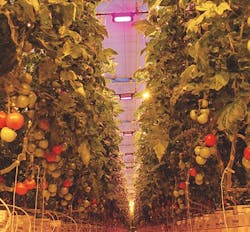Munich takes a small stake in a Montreal company specializing in predicting indoor yields for crops such as tomatoes and cannabis. Lighting’s role in the IoT continues to take root, in hopes that shoots will follow.
Osram continues investing in information technology companies, with an eye again on horticultural production, taking a stake in a Canadian startup company that provides software for predicting yields of indoor and greenhouse crops such as tomatoes and cannabis.
Interested in articles & announcements on smart lighting and IoT applications?
Munich-based Osram joined a $2.85 million early-stage financing round in Montreal-based Motorleaf, a small firm that has developed algorithms that analyze data collected from sensors to determine how well a particular set of plants is doing, and how they will proceed. Motorleaf describes its technology as a form of artificial intelligence (AI).
Earlier Osram horticultural investments have focused more on the optimization of LED light recipes — brightness, doses and spectrum — for varying crops. The Motorleaf backing provides a sort of report card for horticultural lighting and other growing technologies in that it ascertains how things are actually going.
“We see strong potential in leveraging advanced data analytics to further optimize predictability and performance of production in commercial greenhouse and indoor farm production,” said Ulrich Eisele, managing director of Osram’s Fluxunit business accelerator group.
Motorleaf technology helps determine how many of those tomatoes will actually thrive. Eventually it might be able to adjust the lights to increase the chances. (Photo credit: Osram.)
Osram claimed that in a tomato trial with California greenhouse SunSelect, the Motorleaf AI technology reduced yield prediction errors by 50%.
Motorleaf hopes to eventually tie its observation capabilities into other systems such as lighting to activate changes that would improve farm output.
“We’re ultimately producing dynamic grower protocols, which help manage everything from light and nutrients to predicting crop diseases before they happen and optimized growing conditions that increase ROI — all based on real-time data,” said Motorleaf CEO Alastair Monk.
Monk is a regular columnist for Cannabis Business Times, where he recently explained how Motorleaf’s AI would work in a lighting context.
“An example would be monitoring the light (PAR) level and spectrum used in a grow room,” he wrote. “A human won’t go in the room each hour to take a measurement, making sure the right amount of power and correct light spectrum is reaching the plants. However hard you try, simply looking at your HPS lights won’t alert you when they are performing below the optimum range your business needs to maximize production. Our team at Motorleaf is working to make that possible by automating this data collection and automating the alerts that will reach the head grower if any of those lights are underperforming. So that is AI at work.”
The investment comes a few weeks after Osram acquired Austin, TX-based Fluence Bioengineering, a maker of smart LED-based grow lighting systems for indoor farms that has written for LEDs Magazine on energy efficiency and metrics for horticultural lighting. A year ago, Osram’s Fluxunit purchased a minority stake in Agrilution, a Munich company that makes grow boxes for home use.
Osram, like many large lighting companies, has been pushing hard into the information technology area to try to position lighting as a critical carrier in the Internet of Things (IoT). Osram’s many other IoT moves and investments have included an equity position in Switzerland’s beaconsmind AG, which makes software to help engage in-store shoppers via smartphones.
Recently, Osram teamed with mobile-phone networking giant Nokia to experiment with putting 5G transmitters in ceiling luminaires.
Two months ago, the company unveiled an overarching IoT architecture called Lightelligence to try to unify its march into the high-tech world.
The lighting industry’s attempt at transforming itself into a provider of IT and data services has been financially challenging, as both Osram and industry leader Philips have demonstrated over the last month.
Meanwhile, other investors who joined Osram in the Motorleaf round included Radicle Growth, Desjardins Capital, Real Ventures, BDC Capital, and 500 Startups Canada.
MARK HALPER is a contributing editor for LEDs Magazine, and an energy, technology, and business journalist ([email protected]).






